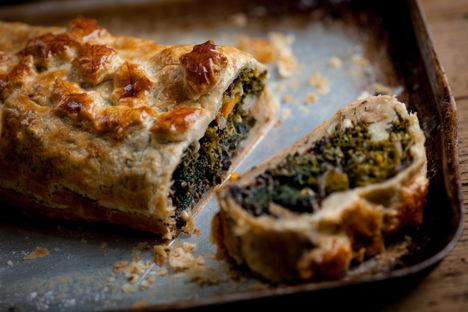
Pastry: A versatile vegetarian solution
Cooking for vegetarians can be a tricky problem, especially when you're more comfortable cooking meat-based meals. Clare explores the options of giving some pastry classics a vegetarian makeover.
Pastry: A versatile vegetarian solution
Cooking for vegetarians can be a tricky problem, especially when you're more comfortable cooking meat-based meals. Clare explores the options of giving some pastry classics a vegetarian makeover.
It’s easy to fall into the trap of having a standard repertoire of dishes we turn to time and time again; whether it’s feeding the family on a frantic weeknight, for a treat at the weekend, or when entertaining friends and loved ones. For the latter, something like a hearty fish pie, a beef Wellington, or even something more unusual such as a chicken, squash and sage pithivier, make fantastic entertaining meals, easily baked in the oven and served as a showstopping centrepiece.
However, these recipes tend to revolve around meat and fish, while vegetarians are often left with a stuffed pepper or salad. It’s a tricky culinary dilemma, do you cook two separate meals, one meat-based, one vegetable-based, or do you try and force the meat-eaters at the table to eat some sort of meat substitute?
The solution is neither. A rich base such as pastry is the perfect carrier of flavours, creating a hearty dish without the need for meat.
Classic variations
A typical quiche lorraine makes an easy lunch, but really, once you’ve got the crumbly shortcrust pastry and creamy egg filling, the bacon is only a salty flavouring. Cheese makes an excellent substitute, while most vegetables make excellent fillings. A combination of Stilton, pepper and mushroom would make for an excellent balance of flavours – tangy, sweet and earthy.
An en croute, Wellington or pithivier are essentially more ways of wrapping up meat and fish, but again, most of them already feature layers of vegetables already that could be added to. In the chicken, squash and sage pithivier recipe, the real flavour comes from the sweetness of the butternut squash and the pungent sage. Boost these with some chunks of nutty celeriac instead of the chicken, perhaps even some walnut halves or cheese, and it’s ready to go.
Looking further afield
Many international cuisines provide wonderful inspiration. The Italians have the right idea with pastas and pizzas forming the perfect bases to show off beautiful vegetables, such as fresh tomatoes and fragrant basil, or sublime cheeses such as mozzarella and taleggio. The French have tarts and galettes that can be equally filled, such as with caramelised shallot and goat’s cheese, or baked as a savoury tarte Tatin with sweet, buttery root vegetables.
From the Middle East, the inclusion of spices and pulses add incredible flavour and sustenance; particularly suited to bite-sized parcels. Something like a chicken and chorizo Moroccan briouat could easily be made with chickpeas and dried apricots, scented with cumin and ginger, or aubergines and feta, such as in these Greek mpourekakia. Mexican empanadas, Indian samosas or Chinese spring rolls offer similar options, with the flavours of herbs and the heat of spices often bolstered (or mellowed) by the inclusion of lentils, potatoes, noodles or vegetables. Easily translated into more familiar forms, something like a spiced vegetable puff pastry roll makes an easy, yet exotic, snack.


